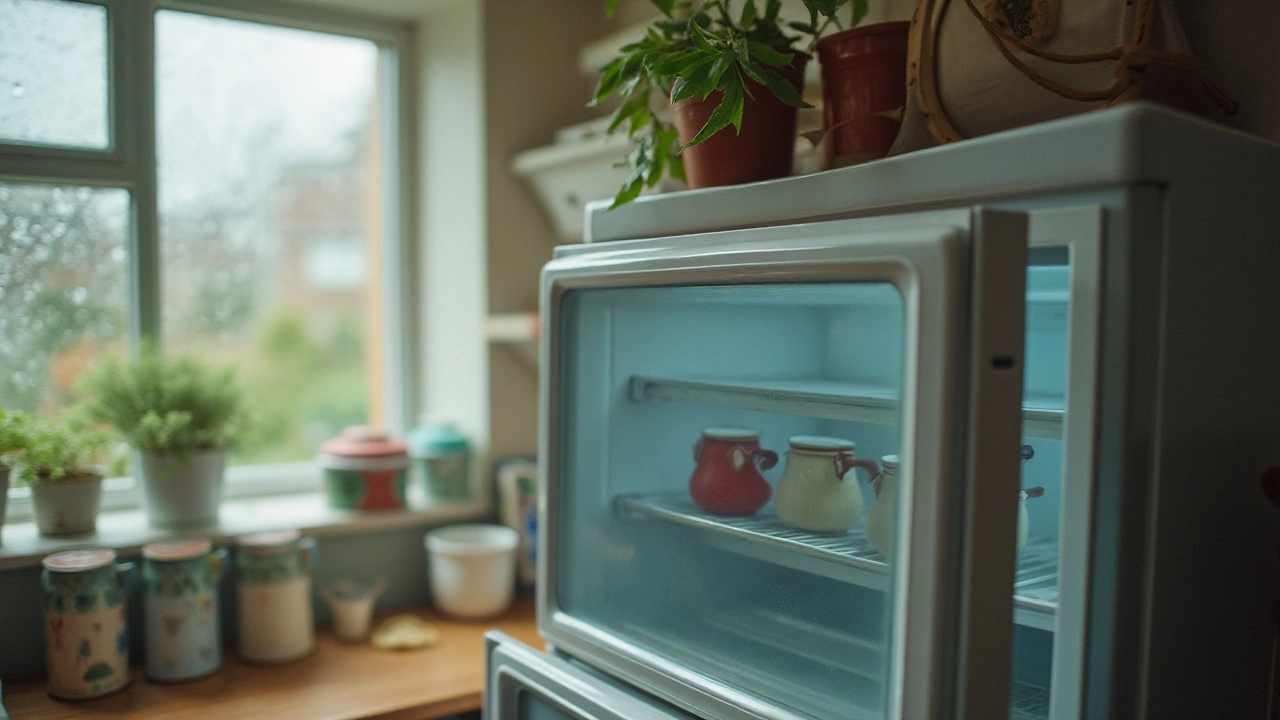
- 4 Aug 2024
- Gideon Thornton
- 0
A fridge not doing its job can be a real headache, but before you panic and start searching for a new one, there might be some simple fixes you can tackle at home.
Refrigerators are complex machines with many parts working in tandem to keep your food fresh. Problems with cooling can arise from various sources, ranging from a misaligned thermostat to something more severe like a faulty compressor.
This guide covers several probable causes for your fridge's cooling troubles and offers practical solutions you can attempt yourself. These steps could help restore your refrigerator's function and even extend its lifespan.
- Common Causes of Cooling Problems
- Easy Fixes You Can Do
- When to Call a Professional
- Preventive Maintenance Tips
Common Causes of Cooling Problems
When your refrigerator doesn’t seem to cool as it should, several potential culprits might be to blame. To begin, let's consider the thermostat settings. Sometimes it’s as simple as a human error where the control is set too high, causing the fridge to be warmer than desired. Always check and adjust the thermostat to a medium setting and allow at least 24 hours to see any change in cooling performance. If it doesn’t cool properly even when set to the correct temperature, the thermostat could be malfunctioning and may require replacement.
Another common reason for cooling problems involves the condenser coils. When these coils, usually located at the back or beneath, become clogged with dust and debris, they can't efficiently expel heat. This often leads to the fridge working harder to maintain the desired temperature. A quick fix is to gently clean the coils with a vacuum cleaner or a coil brush at least every six months.
“Regular maintenance, like cleaning the condenser coils, can decrease energy consumption and increase the life of your appliance by 20%,” says Alex Green, an appliance repair expert with over 15 years of experience.
If cleaning and thermostat adjustments don't do the trick, door seals could be the next suspect. These seals, also known as gaskets, should be airtight to prevent warm air from entering the fridge. A simple way to test the seal is by closing a piece of paper in the door; if it slides out easily, the seal is likely worn out and needs replacement. Replacing the gasket can drastically improve cooling efficiency.
Lastly, ensure there’s adequate clearance around the fridge for proper airflow, as cramped spaces can lead to overheating, especially for models with rear coils. Frequent opening and closing of the door also contribute to the appliance's inefficiency, leading to cooling failures. Addressing these issues is a good starting point for troubleshooting.

Easy Fixes You Can Do
Tackling a refrigerator that's not cooling can seem daunting, but there are a few straightforward tasks you can try before calling in the professionals. One initial step you might consider is to check the thermostat dial. This dial can sometimes get accidentally nudged while you're handling items in the fridge. Make sure it is set to the right cooling temperature, which usually resides in the mid-range, commonly around 37 degrees Fahrenheit for the fridge and 0 degrees for the freezer section.
Check the Door Seals
Next, examine the door seals. They are meant to keep the cool air in and warm air out, and any wear and tear or dirt can greatly affect this function. Simply slide a thin piece of paper, like a dollar bill, between the door and seal. If you can pull it out easily, you might need to clean or replace the seal. Cleaning can often be done with just warm, soapy water. Dr. Janet Manning, a home appliance expert, one said,
"Prevention is simple; maintain the seals for optimal refrigerator performance."
Inspect the Condenser Coils
The condenser coils, typically located at the back or under the fridge, work hard removing heat from the appliance to keep everything cool inside. Over time, these can collect dust and lint, which hinders their efficiency. Most manufacturers recommend brushing or vacuuming them every six months. A simple vacuum hose job or dedicated coil cleaning brush can be remarkably effective.
Ensure Adequate Spacing
Believe it or not, your fridge needs room to breathe. This might sound funny, but it’s crucial for maintaining its life span and cooling efficiency. Make sure there’s at least a couple of inches between the back of the refrigerator and the wall, as well as some space on the sides. This ensures proper airflow to the cooling elements.
Level the Appliance
Also, check if the fridge is level. If it tilts forward or backward, the doors might not seal properly. Your refrigerator should slightly tip backward when balanced correctly, allowing the doors to close automatically. Adjust the feet at the bottom to resolve this if necessary.
Inspect the Vents
One lesser-known tip is to inspect the air vents within the appliance. There should be nothing blocking them, either inside the fridge or the freezer. Obstructions can prevent the cold air from flowing evenly throughout the compartments. Having the right knowledge at hand can save you money and keep your beloved appliance from turning into a costly and unexpected freezer reunion.
Remember, making these fridge repair efforts at home doesn't only save you money but also possesses the potential to extend the life of your trusty appliance.

When to Call a Professional
While many minor fixes can be handled with a bit of elbow grease and some instruction, there are times when calling in a professional is not just the safest course but also the most cost-effective. A seasoned technician can diagnose and resolve complex cooling issues with efficiency and precision, ensuring that your refrigerator is back to its cooling best without unnecessary fuss. But how do you know when it’s time to make that call? Here are some scenarios where a professional's intervention becomes inevitable.
Sometimes, a faulty thermostat might not just refuse to adjust but might even continuously cycle on and off. If you've twisted and turned the dial to no avail, it could be a sign of a deeper electrical issue. Attempting to repair these yourself without the proper know-how can accidentally lead to shorts or even further damage the appliance. Invasive repairs like replacing the thermostat or other electrical components should be left to a pro who understands the intricate architecture of modern refrigeration.
Strange noises can be ominous when coming from your fridge. While a certain level of hum and gurgle is normal, a persistent loud clatter or a grinding noise may indicate issues with the compressor or fan motors. These critical components, if malfunctioning, often require special tools and replacement parts that are best handled by trained technicians. A capable repairman can quickly identify whether the strange sound is a significant issue or a benign annoyance, steering you clear of unnecessary worry and potential hazards.
If there's visible frost build-up in the freezer or erratic temperature fluctuations, these are tell-tale signs of defrost issues. A broken defrost timer or heater can leave you in a bind. Dealing with these components involves understanding the freezer and fridge coils' function, often tucked behind panels and interconnected with electrical wiring. If you’re not familiar with the layout and purposes of these elements, professional servicing is the quickest route to regaining a frost-free freezer and a steady cold temperature.
Occasionally, you'll notice puddles forming around your fridge, pointing to possible issues like a blocked defrost drain or a cracked drain pan. Though these might seem like simple fixes at first glance, detecting the actual source of the water leak can be tricky. An experienced technician, familiar with a variety of models, can trace leaks accurately to their origin and ensure the underlying issues are addressed without lasting damage to your kitchen flooring.
"It's essential to consult with a professional for complex refrigerator issues," advises James Adams, a renowned appliance repair expert. "Attempting DIY repairs in such scenarios can sometimes result in more harm than good, potentially voiding warranties and escalating repair costs."
Lastly, if you find your appliance consistently struggling despite several at-home tweaks, gauge a repairperson’s expertise. This might be due to an issue with the sealed system, which encompasses components like the compressor, evaporator, and condenser. These systems are pressurized and sealed, usually warranting specialized tools and replacement parts that you, as a homeowner, are unlikely to have on hand. Professionals are equipped with appropriate skills and equipment to open the sealed system, conduct necessary tests, and re-seal it to keep your fridge functioning optimally.
Calling in an expert isn’t just about taking the easy way out; it’s about making a smart choice for the appliance's longevity and safety. Refrigeration systems can be deceptively complex, and a technician's expertise might offer a solution that you might not have considered or known was possible. It's about the peace of mind knowing your cooling issues are in capable hands while preventing minor problems from ballooning into costly replacements.

Preventive Maintenance Tips
It's no secret that keeping your refrigerator in tip-top shape requires some regular attention. Just like how we need routine check-ups to stay healthy, appliances need a bit of TLC as well. The good news is that a little preventive care can go a long way in ensuring your fridge runs efficiently and avoids unexpected breakdowns. For starters, regularly cleaning the condenser coils is crucial. These coils, typically located at the back or underneath the fridge, can get covered in dust and debris which can severely limit their effectiveness. Just like when you have to clear out a clogged drain for water flow, dirty coils can restrict airflow and cause the fridge to work harder, using more energy than necessary. Vacuuming or brushing the coils every few months can make a significant difference.
Another simple yet vital practice is checking the door seals. The rubber gaskets create a tight seal to keep the cool air in, yet they can become cracked or sticky over time. To test if the seals are doing their job properly, close the door over a dollar bill. If you can easily slide the paper out, it might be time to replace the seal. This seemingly small step can prevent your refrigerator from becoming overworked as it tries to maintain its cool temperatures, saving on energy bills and reducing wear and tear.
Setting the right temperature is another factor often overlooked. The optimum range is between 37°F and 40°F for the fridge compartment, while the freezer should be at 0°F. This ensures food stays fresh without causing the appliance to work harder than necessary. An often-quoted recommendation from the U.S. Food and Drug Administration suggests placing an appliance thermometer in your fridge periodically to monitor this. Keeping a consistent temperature is key not just for energy efficiency but also for food safety.
Water filters are another component that need regular attention. If your fridge dispenses water or has an ice-making feature, changing the filter every six months is vital. Over time, these filters can become clogged with particles, and sometimes even bacteria, which can not only affect taste but also ice production. Installing a new filter can significantly enhance performance and ensure that you’re consuming clean, healthy water.
Lastly, maintaining proper organization in your refrigerator can help in several ways. An overstuffed fridge can restrict air circulation, making it harder to keep a consistent internal temperature. An easy rule of thumb is to allow space between items and avoid blocking the air vents. This practice doesn't just optimize cooling, it also helps you see what you have, minimizing the frequency of forgotten items turning into waste. With a little bit of routine care, your refrigerator will be able to fulfill its role seamlessly, and might even add a few extra years to its life span.




